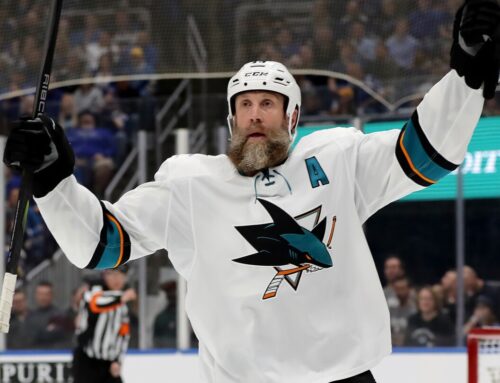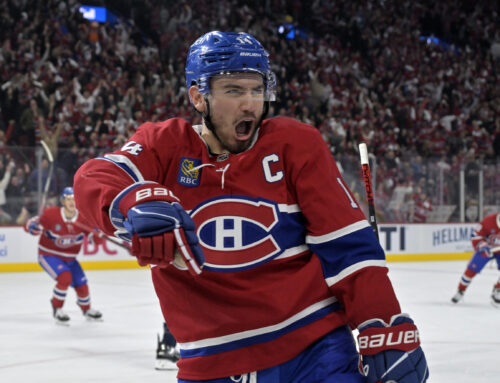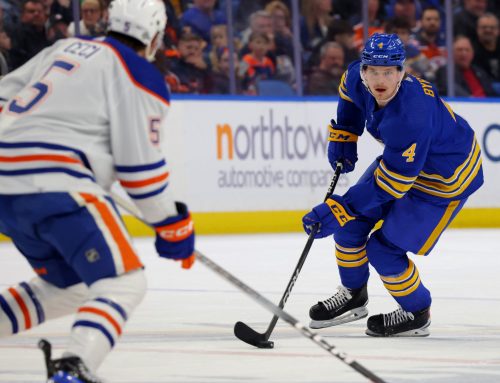
It’s almost here! Tomorrow is the day the 2018-19 Dobber Hockey fantasy guide is released. There are projections, articles from the Dobber team, and a whole host of other fantasy goodness for readers. Be sure to head to the Dobber Shop and get yours early.
*
A special thanks to the contributors here at Dobber Hockey for making Bubble Keeper Week a resounding success. They do a great job of researching the topics necessary for our readers to succeed in their leagues and covering this topic seemed to help a lot of people make some tough decisions. Or at the least, helped provide a much-needed second perspective.
And thank you to the readers. I know there are some people that just like to avoid hockey for a couple months and you guys hopping into our comments, asking us questions on Twitter, and perusing are articles is what made the week as fun as it was.
*
Jarome Iginla had his retirement press conference yesterday. Rather than rambling on (pun intended) about his career accomplishments (I’ve already done that), I thought this was an interesting story to come out from Sportsnet:
Brian Burke just told me on-air that before signing Jaromir Jagr last season, the Flames had long talks about bringing Iginla back, but chose to sign 68 instead.
— Faizal Khamisa (@SNFaizalKhamisa) July 30, 2018
Hindsight is obvious now considering how things worked out with Jagr but it would have been cool to see Iginla have his final season in a Flames uniform. He would have been limited, sure, but seeing the send-off the Sedins had in Vancouver was special and it would have been just as awesome to see Iginla do the same.
*
According to Elliotte Friedman, Cody Ceci is asking for $6-million in arbitration while the team offered $3.35-million. Splitting the difference, barring a deal between now and the conclusion of the arbitration case, cap leaguers can expect Ceci’s contract to be about $4.6-million or so this year. He could be worth that in real-time stats leagues but is certainly not worth that in leagues that don’t count hits and blocked shots.
*
There was an interesting article over at TSN yesterday from Travis Yost. He contextualized Brock Boeser’s rookie season to see what kind of comparable seasons there had been in the past. The name that topped the list was Patrik Laine. He then looked for comparable 2017-18 seasons for Laine and Boeser’s name topped the list. I encourage you to read the article to get the entire context, but Boeser and Laine were the closest comparable names for both.
That’s not what interested me, though. What interested me was the second name on the list of comparable seasons for both Boeser and Laine: Alex DeBrincat.
As Yost mentioned, having a season like they did will produce similar names. Nonetheless, seeing DeBrincat’s name listed alongside two players on the verge of superstardom has me excited for what DeBrincat could bring in 2018-19.
*
Reading Cam’s Ramblings from yesterday, I agreed with him on one point: keep an eye on Kailer Yamamoto. I know the team signed Ty Rattie and Drake Caggiula, but there’s a very real possibility that both Yamamoto and Jesse Puljujarvi are the right wingers on the top two lines this year.
Yamamoto showed very well in his nine-game stint even if he didn’t find the score sheet. The line generated a lot of chances and sometimes players are just snake-bit for a couple weeks. Puljujarvi was better than people realized last year, he just didn’t get a real opportunity to shine.
I’m excited to see the line combinations they go with in camp. It seems very plausible something like RNH-McDavid-Yamamoto and Rieder-Draisaitl-Puljujarvi is run as the top-6. Maybe they do stick with Rattie on the top line to start but I don’t see it as a long-term solution. There may not be a need to draft either Yamamoto or Puljujarvi in most fantasy leagues, or Yamamoto at least, but be quick on the waiver wire.
*
Kevin Hayes signed a one-year, $5.125-million contract with the Rangers on Monday, avoiding arbitration. He’ll be a UFA after the year so it seems like he’ll be a deadline asset to trade. That’s a lot for cap-league owners, though.
*
Replying to a comment the other day in my Ramblings about Evgeni Dadonov made me realize something: Dylan Larkin had 63 points last year, and only eight of the came on the power play. Not only that, he was the first forward in a decade to tally at least 63 points while shooting under 7 percent. The last forward under the age of 25 to do it was Brad Richards in 2002-03. That’s not actionable fantasy information, I just found that interesting.
Anyway, it’s not hard to see Larkin having a monster season this year. He had a career-best in individual points percentage but the level he found himself shouldn’t be a concern. He was at about 73 percent and the top playmakers and producers in the NHL, names like Kopitar, Panarin, MacKinnon, Hall, and Gaudreau found themselves in the 70-80 percent range. If the belief is Larkin is a burgeoning star (that is my belief), his IPP level isn’t a concern.
If that shooting percentage rebounds (it will; he can’t shoot 3.7 percent on the power play again), and he can boost his PP production overall, there could be a huge year coming. As always, the caveat is that my personal projections won’t be finished for another month (I don’t know how Dobber does it) but if Larkin pushed to be nearly a point-per-game player this year, it wouldn’t surprise me in the least. He’ll probably be on a lot of my teams.
*
For as little there is to talk about hockey in late July, this tweet from Dobber kicked up a pretty good debate:
Claude Giroux is 30 years old. He will most certainly reach 1000 career points before he's done.
Hall of Famer?— Dobber (@DobberHockey) July 27, 2018
The topic of Hall of Famers from the current generation is one I’ve been thinking about lately. There are slam-dunk cases which don’t warrant discussion like Sidney Crosby, Alex Ovechkin, Jarome Iginla, and the like. It’s the borderline guys who bring the debates. Guys like Giroux, Dany Heatley, Jason Spezza, Rick Nash, and Marian Gaborik. Before you yell at me, I’m not saying those guys are all Hall of Famers. I’m saying after the obvious cases, there are maybe 20 guys worthy of at least a discussion. They are some of the names on that list.
Anyway, back to Giroux.
He was late becoming a full-time NHLer, with his first full season coming at the age of 22. Was it really his fault they let him toil in the QMJHL and AHL before bringing him up? He had 48 goals and 112 points in 63 games in his D+1 year and 38 goals and 106 points in 55 games in his D+2 year. They had him start 2008-09 in the AHL and he was over a point per game for nearly half the season. While I don’t know the circumstances around keeping him off the full-time roster for so long (maybe Philly fans can shed some light in the comments), he appeared ready offensively long before he got to the NHL for an 82-game season.
Over the last eight years, he ranks 2nd in points (only Crosby is ahead), 5th in points per game (ahead of names like Ovechkin, Tavares, and Getzlaf), and 1st in assists. Those are very impressive numbers that span nearly a decade.
There’s always the question of hardware. There are zero MVPs, zero scoring titles, and zero Cups. Those things matter to HOF voters. If the Flyers win a Cup in the next few years, this is a different conversation for a lot of people.
The final sticking point is usually one of whether he was considered one of the top players of the sport at a given moment. I think some people might remember the Baton Has Been Passed arguments from years ago which were always silly. Giroux did have a five-year span (2010-2015) where he led the league in points. Guys like Crosby and Ovechkin were certainly still the impact players ahead of him, but of the non-generational players, it’s hard to look down your nose at a player who led the entire league in scoring for five years.
A final determination cannot be made right now, obviously. Giroux is heading into his age-31 season and there’s no telling what the future holds. What if he puts up a couple more 90-point seasons? What if he puts up a couple more 90-point seasons *and* adds a Stanley Cup? Or maybe he continues hardware-less for his career, 2017-18 proves an anomaly, and he returns to the production levels of 2015-17. Regardless, where he stands right now, outside of the guys that are clearly HOF-bound, Giroux is at, or near, the top of the next tier.
*
I guess it’s time to weigh in on the Tom Wilson contract.
The first thing that jumped out at me: there really aren’t (m)any comparable contracts. We are looking for the following conditions:
- Early 20s and an RFA
- Low career goal totals
- Low career point totals
- High career PIM totals
- Stanley Cup
- Long-term contract with a significant cap hit
That’s why when I see a name like David Clarkson thrown about, it doesn’t really apply. He signed his deal after his age-28 season as a UFA. You can’t really use guys like Antoine Roussel, either (though seeing what he signed for as a UFA should give you an idea about the value of Wilson’s contract). There was this tweet from Jeff Veillette:
Chart for an upcoming @faceoffcircleca article: Here is how Tom Wilson's point production stacks up to what @CapFriendly feels are the most comparable contracts to his in the cap era, and how those players produced leading up to their deals: pic.twitter.com/agZ2nubbpr
— Jeff Veillette (@JeffVeillette) July 29, 2018
None of the players on that list fits his description to a tee, but one sticks out: Andrew Shaw.
Shaw signed his deal with the Habs after his age-24 year, had never cracked 40 points, had one 20-goal season, and had two Stanley Cups. His contract was for six years at $3.9-million (which, again, despite cap increases, should tell you the value of the Wilson contract).
Anyway, that’s where the argument gets lost. The argument isn’t whether they are NHLers. Both Wilson and Shaw are good enough on talent alone to be on someone’s third or fourth line. The question is whether they are 100% worth the value of the contract, or 80% of the contract, or 60%, or 50%. Saying, “maybe they overpaid by $1.5M or $2M a year but it’s not a big deal” misses the point. Washington is a team with $1.1-million in cap space. Next year, they have over $67-million in commitments with just 13 players signed and Jakub Vrana, Andre Burakovsky, Chandler Stephenson, and Christian Djoos as RFAs. It’s a very real possibility that in 300 days they’ll need that extra $2M in cap space.
Again, this isn’t a “he’s not an NHLer” argument. He’s the prototypical cap-era fighter. A guy who can both throw punches and play with skilled players while not being an anchor to that line. The question is whether that particular skill set is worth nearly $5.2-million a year and whether it might cost them the ability to sign someone like Burakovsky in 10 months. We’ve seen this happen often recently with Cup champions. Players get signed to long-term deals and then when the cap crunch comes they get bought out, traded for another bad contract, or shipped out of town with a young player and/or draft picks to rid the team of the contract.
The Caps have their Cup in the Ovechkin Era. It really doesn’t matter what they do for the next decade. They could be a lottery team for years and the fans will always have this one magical year. And maybe Wilson takes another step in development, though at the age of 24, most players are pretty much done developing.
For fantasy, cap owners will have a decision to make. In leagues that count hits and PIMs, he’ll probably still be worth his contract. He’s one of the elite in both categories, and if he can continue to provide double-digit goals and 30-some points, it’s worth it. In leagues that don’t count hits or PIMs (especially both), he’s not worth it.





 UTA
UTA PHI
PHI VGK
VGK EDM
EDM
 VAN
VAN L.A
L.A ANA
ANA NYI
NYI SEA
SEA
